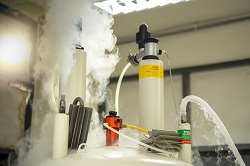A new methodology for measuring NMR at very low magnetic fields
When it comes to chemical analysis, high-field Nuclear magnetic resonance (NMR) is the go-to technique for elucidating molecular form, structure and function and for imaging chemical samples in a non-destructive way. Outside of hospitals and the pharma industry, one of the major uses of NMR is to provide unique information about fluid fields, surface affinity and surface chemistry of porous-solid catalyst supports and in rocks. Although beneficial, NMR is often expensive and requires the use of strong magnetic fields that aren’t compatible with a number of materials that need to be studied. To overcome this downside, the EU-funded ODMR-CHEM project developed a set of tools that allow scientists to study fluids and chemical activity in mixtures of solid and liquid matter that are found in heterogeneous-phase reactions. “Our aim was to overcome this challenge by using NMR at very low magnetic fields, with a focus on fast and efficient chemical sensing, portability and low cost,” says Project Researcher Dr Michael Tayler. Introducing the atomic magnetometer A key result of the project was its building on recent developments in atomic magnetometers and the development of a new methodology for measuring NMR at very low magnetic fields. “Atomic magnetometers are the most sensitive magnetic sensors currently available,” explains Tayler. “Furthermore, as they are both highly sustainable and scalable, magnetometers are an area of strategic importance for EU research programmes.” The road to developing this methodology began at the University of California, Berkeley (USA), where Tayler learned how to build magnetometers and use them as NMR sensors under the guidance of leading research groups. He then brought this knowledge to Cambridge University’s Department of Chemical Engineering, where his research focused on using NMR to study catalyst chemistry in-situ and under operando conditions. In addition to – and in support of – the methodology, project researchers also built a spectrometer used for low-field NMR research at Cambridge. Not only is the instrument being used to study chemistry in porous materials, but researchers are also investigating its potential use as a low-cost reaction monitoring tool suitable for everyday laboratory use. “World-leading instruments are important in science when you are looking for new phenomena,” says Tayler. “By building your own, like we did in the ODMR-CHEM project, you are able to control the experiments and thus make new discoveries more quickly.” Ongoing progress Although the project has officially closed, work continues. For example, researchers are currently working with the Cambridge lab and a major player in the petrochemicals industry. “Together, we are investigating how the techniques developed during the ODMR-CHEM project can be applied to understanding how real-world catalysts work and how that knowledge can be used to maximise their efficiency,” adds Tayler. “So far, the results have been extremely positive.” Together with other groups in Europe, Tayler has also helped create a network for ultralow-field magnetic resonance research focused on medical diagnosis, ultrahigh-resolution imaging, chemical analysis and fundamental physics. The consortium recently received funding under the Marie Curie ITN/Horizon 2020 ZULF NMR project.
Keywords
ODMR-CHEM, spectrometer, chemical analysis, nuclear magnetic resonance (NMR), magnetometers

